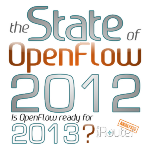
What will OpenFlow do for Networking in 2013? We are a little over a week into the testing phase of our State of OpenFlow 2012 report. One trend we are following is the entrance of new vendors focusing on hardware and limited software, relying on Network APIs for control. On Friday we received a new OpenFlow based switch with 10G and 40G ports. We were able to confirm t … [Read more...]